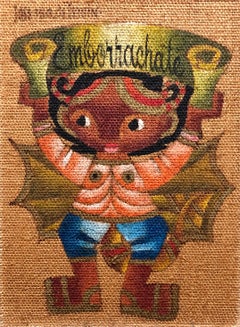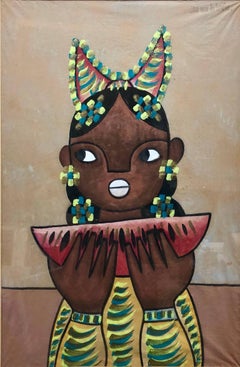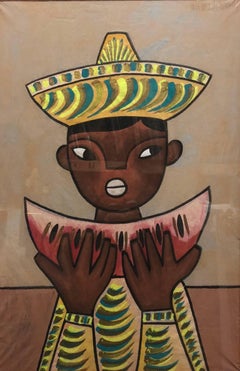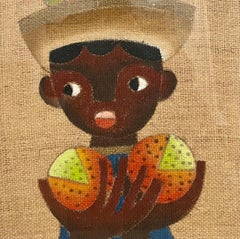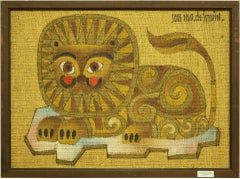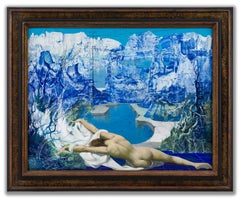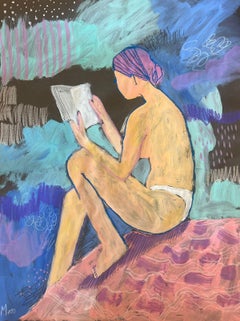Jose Maria de Servin Art
to
9
8
1
3
3
3
Overall Height
to
Overall Width
to
4
4
4
4
3
2
1
1
9
12
6,886
3,210
2,514
1,217
9
7
7
7
2
Artist: Jose Maria de Servin
Folk Art Mexican Girl "Emborrachate" Oil Painting on Burlap
By Jose Maria de Servin
Located in Surfside, FL
The sweetness that characterizes the work of Mexican painter Jose Maria de Servin (1917-83) is a melancholy and placid one. While he worked in the most modern of styles, he adapted i...
Category
Mid-20th Century Folk Art Jose Maria de Servin Art
Materials
Burlap, Oil
Folk Art Mexican Girl with Watermelon Oil Painting on Burlap
By Jose Maria de Servin
Located in Surfside, FL
The sweetness that characterizes the work of Mexican painter Jose Maria de Servin (1917-83) is a melancholy and placid one. While he worked in the most modern of styles, he adapted i...
Category
Mid-20th Century Folk Art Jose Maria de Servin Art
Materials
Burlap, Oil
Mexican Modernist Painting Girl with Watermelon
By Jose Maria de Servin
Located in Surfside, FL
Genre: Latin American
Subject: Children
Medium: Mixed Media
Surface: Paper
Country: Mexico
Dimensions include Frame: 36X26
The sweetness that characterizes the work of Mexican pai...
Category
20th Century Folk Art Jose Maria de Servin Art
Materials
Paper, Gouache
Mexican Modernist Painting Boy with Watermelon
By Jose Maria de Servin
Located in Surfside, FL
Genre: Latin American
Subject: Children
Medium: Mixed Media
Surface: Paper
Country: Mexico
Dimensions include Frame: 36X26
The sweetness that characterizes the work of Mexican pai...
Category
20th Century Folk Art Jose Maria de Servin Art
Materials
Paper, Gouache
Folk Art Mexican Boy Oil Painting on Burlap Charming Naive African American Art
By Jose Maria de Servin
Located in Surfside, FL
Framed 29 X 23
Image 18 X 24
The sweetness that characterizes the work of Mexican painter Jose Maria de Servin (1917-83) is a melancholy and placid one. While he worked in the most modern of styles, he adapted it to an anecdotal folk-art approach distinctly his own.
When he was an infant, de Servin's family moved with him to Guadalajara. A city of history and culture, Guadalajara had a thriving artistic community with strong connections to Europe. His brothers Antonio and Miguel became artists as well, and in later years they worked collaboratively. As a teenager, de Servin studied at one of Mexico's Schools of Open-Air Painting, free art-teaching institutions sponsored by the government.
Later de Servin became a pupil of the painter Chucho Reyes, known for his improvisational watercolor variations on traditional Mexican themes. This interest in imagery particular to Mexico would be of great significance to de Servin. De Servin also studied under the more traditional painter Jose Vizcarra. In the early 1930s de Servin joined the Pintores Jovenes de Jalisco, or Young Painters of Jalisco.
An influence of critical importance to de Servin was Pablo Picasso. One of the originators of Cubism, the Spanish painter soon departed from its quasi-scientific and optical basis to create lively and humorous geometrical abstractions. It was this Cubism, personal and decorative, that de Servin adopted. His earliest Cubist works mimic Picasso, while during the second stage of his career, his works become smooth and polished, with an emphasis on gentle surface textures.
After these cautious years, however, a rough boldness enters along with dominating colors of earth and sand. Modernists like de Servin were interested in exploring what they considered primitive artmaking styles. The adoption of a native manner and native themes is in keeping with Modernist tenets, as is the use of nontraditional materials. De Servin's portraits of peasants, large-eyed and simply rendered, recall children's drawings. The rough burlap ground contrasts with the playful imagery and delicate range of color. The figures, all children or child-like adults, are all curves and simple shapes arranged harmoniously. De Servin's cubism is free from grotesquerie as it celebrates the simplicity of its subjects.
De Servin worked with the social-realist Jose Orozco on several large mural commissions in Guadalajara, including one at the Legislative Palace. While their styles were dissimilar, both made use of Mexican imagery to glorify the common people. A sought-after muralist in his own right, de Servin brought the rich colors and endearing characters of his panels to his larger-scale work.
For 15 years, de Servin taught summer art classes at the University of Arizona. His career was marked by many one-man shows, both in North America and Europe. In recent years, his striking style has attracted increased notice from critics and the public.
His style is a unique conglomerate of tradition, history, legends, heroes, old customs and folklore. It is a self-standing style, recognizable, cheerful, whimsical and a happy creation. Naïve art is any form of visual art that is created by a person who lacks the formal education and training that a professional artist undergoes (in anatomy, art history, technique, perspective, ways of seeing). Unlike folk art, naïve art does not necessarily evince a distinct cultural context or tradition. Naïve art is recognized, and often imitated, for its childlike simplicity and frankness. Paintings of this kind typically have a flat rendering style with a rudimentary expression of perspective.
One particularly influential painter of "naïve art" was Henri Rousseau (1844–1910), a French Post-Impressionist who was discovered by Pablo Picasso. Naïve art is often seen as outsider art that is by someone without formal (or little) training or degree. While this was true before the twentieth century, there are now academies for naïve art. Naïve art is now a fully recognized art genre, represented in art galleries worldwide.
Museums devoted to naïve art now exist in Kecskemét, Hungary; Riga, Latvia; Jaen, Spain; Rio de Janeiro, Brasil; Vicq France and Paris. "Primitive art" is another term often applied to art by those without formal training, but is historically more often applied to work from certain cultures that have been judged socially or technologically "primitive" by Western academia, such as Native American, sub saharan African or Pacific Island art (see Tribal art). This is distinguished from the self-conscious, "primitive" inspired movement primitivism. Another term related to (but not completely synonymous with) naïve art is folk art. There also exist the terms "naïvism" and "primitivism" which are usually applied to professional painters working in the style of naïve art (like Paul Gauguin, Mikhail Larionov, Paul Klee).
At all events, naive art can be regarded as having occupied an "official" position in the annals of twentieth-century art since - at the very latest - the publication of the Der Blaue Reiter, an almanac in 1912. Wassily Kandinsky and Franz Marc, who brought out the almanac, presented 6 reproductions of paintings by le Douanier' Rousseau (Henri Rousseau), comparing them with other pictorial examples. However, most experts agree that the year that naive art was "discovered" was 1885, when the painter Paul Signac became aware of the talents of Henri Rousseau and set about organizing exhibitions of his work in a number of prestigious galleries. The Earth Group (Grupa Zemlja) were Croatian artists, architects and intellectuals active in Zagreb from 1929 to 1935. The group included the painters Krsto Hegedušić, Edo Kovačević, Omer Mujadžić, Kamilo Ružička, Ivan Tabaković, and Oton Postružnik, the sculptors Antun Augustinčić, Frano Kršinić, and the architect Drago Ibler. A term applied to Yugoslav (Croatian) naive painters working in or around the village of Hlebine, near the Hungarian border, from about 1930. Some of the best known naive artists are Dragan Gaži, Ivan Generalić, Josip Generalić, Krsto Hegedušić, Mijo Kovačić, Ivan Lacković-Croata, Franjo Mraz, Ivan Večenaj and Mirko Virius. Camille Bombois (1883–1970) Ferdinand Cheval, known as 'le facteur Cheval' (1836–1924) Henry Darger (1892–1973) L. S. Lowry (1887–1976) Grandma Moses, Anna Mary Robertson (1860–1961) Nikifor (1895–1968) Poland, Horace Pippin (1888–1946) Jon Serl (1894-1993) United States Alfred Wallis (1855–1942) Scottie Wilson (1890–1972) Gesner Abelard...
Category
Mid-20th Century Folk Art Jose Maria de Servin Art
Materials
Burlap, Oil
Mexican Whimsical Folk Art Lion Painting Animalia
By Jose Maria de Servin
Located in Surfside, FL
Painting on burlap by Jose Maria de Servin of an Abstract Naive Lion animal using bright colors and geometric patterns. In this piece the artist simplifies the representation of the ...
Category
Mid-20th Century Folk Art Jose Maria de Servin Art
Materials
Burlap, Oil
Folk Art Mexican Girl, Circus Clown Juggler
By Jose Maria de Servin
Located in Surfside, FL
The sweetness that characterizes the work of Mexican painter Jose Maria de Servin (1917-83) is a melancholy and placid one. While he worked in the most modern of styles, he adapted i...
Category
Mid-20th Century Folk Art Jose Maria de Servin Art
Materials
Burlap, Oil
Folk Art Mexican Girl Oil Painting on Burlap Charming Naive African American Art
By Jose Maria de Servin
Located in Surfside, FL
Framed 29 X 23
Image 18 X 24
The sweetness that characterizes the work of Mexican painter Jose Maria de Servin (1917-83) is a melancholy and placid one. While he worked in the most modern of styles, he adapted it to an anecdotal folk-art approach distinctly his own.
When he was an infant, de Servin's family moved with him to Guadalajara. A city of history and culture, Guadalajara had a thriving artistic community with strong connections to Europe. His brothers Antonio and Miguel became artists as well, and in later years they worked collaboratively. As a teenager, de Servin studied at one of Mexico's Schools of Open-Air Painting, free art-teaching institutions sponsored by the government.
Later de Servin became a pupil of the painter Chucho Reyes, known for his improvisational watercolor variations on traditional Mexican themes. This interest in imagery particular to Mexico would be of great significance to de Servin. De Servin also studied under the more traditional painter Jose Vizcarra. In the early 1930s de Servin joined the Pintores Jovenes de Jalisco, or Young Painters of Jalisco.
An influence of critical importance to de Servin was Pablo Picasso. One of the originators of Cubism, the Spanish painter soon departed from its quasi-scientific and optical basis to create lively and humorous geometrical abstractions. It was this Cubism, personal and decorative, that de Servin adopted. His earliest Cubist works mimic Picasso, while during the second stage of his career, his works become smooth and polished, with an emphasis on gentle surface textures.
After these cautious years, however, a rough boldness enters along with dominating colors of earth and sand. Modernists like de Servin were interested in exploring what they considered primitive artmaking styles. The adoption of a native manner and native themes is in keeping with Modernist tenets, as is the use of nontraditional materials. De Servin's portraits of peasants, large-eyed and simply rendered, recall children's drawings. The rough burlap ground contrasts with the playful imagery and delicate range of color. The figures, all children or child-like adults, are all curves and simple shapes arranged harmoniously. De Servin's cubism is free from grotesquerie as it celebrates the simplicity of its subjects.
De Servin worked with the social-realist Jose Orozco on several large mural commissions in Guadalajara, including one at the Legislative Palace. While their styles were dissimilar, both made use of Mexican imagery to glorify the common people. A sought-after muralist in his own right, de Servin brought the rich colors and endearing characters of his panels to his larger-scale work.
For 15 years, de Servin taught summer art classes at the University of Arizona. His career was marked by many one-man shows, both in North America and Europe. In recent years, his striking style has attracted increased notice from critics and the public.
His style is a unique conglomerate of tradition, history, legends, heroes, old customs and folklore. It is a self-standing style, recognizable, cheerful, whimsical and a happy creation. Naïve art is any form of visual art that is created by a person who lacks the formal education and training that a professional artist undergoes (in anatomy, art history, technique, perspective, ways of seeing). Unlike folk art, naïve art does not necessarily evince a distinct cultural context or tradition. Naïve art is recognized, and often imitated, for its childlike simplicity and frankness. Paintings of this kind typically have a flat rendering style with a rudimentary expression of perspective.
One particularly influential painter of "naïve art" was Henri Rousseau (1844–1910), a French Post-Impressionist who was discovered by Pablo Picasso. Naïve art is often seen as outsider art that is by someone without formal (or little) training or degree. While this was true before the twentieth century, there are now academies for naïve art. Naïve art is now a fully recognized art genre, represented in art galleries worldwide.
Museums devoted to naïve art now exist in Kecskemét, Hungary; Riga, Latvia; Jaen, Spain; Rio de Janeiro, Brasil; Vicq France and Paris. "Primitive art" is another term often applied to art by those without formal training, but is historically more often applied to work from certain cultures that have been judged socially or technologically "primitive" by Western academia, such as Native American, sub saharan African or Pacific Island art (see Tribal art). This is distinguished from the self-conscious, "primitive" inspired movement primitivism. Another term related to (but not completely synonymous with) naïve art is folk art. There also exist the terms "naïvism" and "primitivism" which are usually applied to professional painters working in the style of naïve art (like Paul Gauguin, Mikhail Larionov, Paul Klee).
At all events, naive art can be regarded as having occupied an "official" position in the annals of twentieth-century art since - at the very latest - the publication of the Der Blaue Reiter, an almanac in 1912. Wassily Kandinsky and Franz Marc, who brought out the almanac, presented 6 reproductions of paintings by le Douanier' Rousseau (Henri Rousseau), comparing them with other pictorial examples. However, most experts agree that the year that naive art was "discovered" was 1885, when the painter Paul Signac became aware of the talents of Henri Rousseau and set about organizing exhibitions of his work in a number of prestigious galleries. The Earth Group (Grupa Zemlja) were Croatian artists, architects and intellectuals active in Zagreb from 1929 to 1935. The group included the painters Krsto Hegedušić, Edo Kovačević, Omer Mujadžić, Kamilo Ružička, Ivan Tabaković, and Oton Postružnik, the sculptors Antun Augustinčić, Frano Kršinić, and the architect Drago Ibler. A term applied to Yugoslav (Croatian) naive painters working in or around the village of Hlebine, near the Hungarian border, from about 1930. Some of the best known naive artists are Dragan Gaži, Ivan Generalić, Josip Generalić, Krsto Hegedušić, Mijo Kovačić, Ivan Lacković-Croata, Franjo Mraz, Ivan Večenaj and Mirko Virius. Camille Bombois (1883–1970) Ferdinand Cheval, known as 'le facteur Cheval' (1836–1924) Henry Darger (1892–1973) L. S. Lowry (1887–1976) Grandma Moses, Anna Mary Robertson (1860–1961) Nikifor (1895–1968) Poland, Horace Pippin (1888–1946) Jon Serl (1894-1993) United States Alfred Wallis (1855–1942) Scottie Wilson (1890–1972) Gesner Abelard...
Category
Mid-20th Century Folk Art Jose Maria de Servin Art
Materials
Burlap, Oil
Mexican Boy with Bird
By Jose Maria de Servin
Located in Surfside, FL
The sweetness that characterizes the work of Mexican painter Jose Maria de Servin (1917-83) is a melancholy and placid one. While he worked in the most modern of styles, he adapted i...
Category
20th Century Jose Maria de Servin Art
Materials
Burlap, Oil
Related Items
The Fall of Icarus
Located in London, GB
Gouache on paper, signed (lower left) and titled (lower right), 68cm x 88cm, (88cm x 108cm framed). The work is framed behind museum quality non-reflective UV glass.
A realist pain...
Category
1960s Post-War Jose Maria de Servin Art
Materials
Paper, Gouache
Girl with a book , 65x50cm
By Aleksandra Mato
Located in Yerevan, AM
Girl with a book
Category
2010s Contemporary Jose Maria de Servin Art
Materials
Paper, Pastel, Gouache
American Folk Art Style -- Mahantango Valley Farm Landscape
By Pamela Schooley
Located in Soquel, CA
Absolutely charming folk art style study titled, "Mahantango Valley Farm" by Pamela Schooley (American, 20th Century). Presented in a wooden frame. Signed ...
Category
1980s Folk Art Jose Maria de Servin Art
Materials
Oil, Canvas
H 16 in W 20 in D 1 in
English 19th century Folk Art portrait of a dog, terrier, hound landscape
Located in Woodbury, CT
Acquiring an early 19th-century English painting of a hound or terrier in a landscape circa 1850 is an opportunity to own a captivating piece of art that not only celebrates the arti...
Category
1850s Folk Art Jose Maria de Servin Art
Materials
Canvas, Oil
Ella Fitzgerald Sings Duke Ellington (Grammy, Album Art, Iconic, Jazz, Big Band)
By Kerry Smith
Located in Kansas City, MO
Kerry Smith
Ella Fitzgerald Sings Duke Ellington
Mixed Media on Crescent board
Year: 2022
Size: 21x20in
Signed, dated by hand
COA provided
Ref.: 924802-1636
------------------------...
Category
2010s Outsider Art Jose Maria de Servin Art
Materials
Mixed Media, Acrylic, Gouache, Board
San Miguel, St. Michael, School of Cusco, Peru, Framed early 1900's
Located in Houston, TX
This is painting is from the School of Cusco depicting St. Michael the Archangel defeating the devil in battle. It is oil on canvas and is in very goo...
Category
Early 20th Century Folk Art Jose Maria de Servin Art
Materials
Canvas, Oil
Scottish 20th Century naive oil painting of figures, dogs and birds in interior
Located in Petworth, West Sussex
Catriona Millar (Scottish, b. 1956)
Veva’s Guest
Oil on canvas
Signed with initials (lower left)
19.5/8 x 15.5/8 in. (50 x 39.7 cm.)
Catriona Millar (born 1956) is a Scottish figura...
Category
20th Century Folk Art Jose Maria de Servin Art
Materials
Oil, Canvas
H 19.63 in W 15.63 in D 1 in
Lover Boy, colorful humorous woman and Cat
By Stephen Basso
Located in Brooklyn, NY
oil on linen on mounted board
*ABOUT Stephen Basso
Stephen Basso's highly original pastels and oil paintings are romantic, yet thought provoking fanta...
Category
2010s Outsider Art Jose Maria de Servin Art
Materials
Oil, Linen
Scottish 20th Century naive oil painting of figures, dogs and birds in interior
Located in Petworth, West Sussex
Catriona Millar (Scottish, b. 1956)
Holiday
Oil on canvas
Signed with initials (lower left)
19.5/8 x 15.5/8 in. (50 x 39.7 cm.)
Catriona Millar (born 1956) is a Scottish figurative ...
Category
20th Century Folk Art Jose Maria de Servin Art
Materials
Oil, Canvas
H 19.63 in W 15.63 in D 1 in
Scottish 20th Century naive oil painting 'Beautiful betsy' with ginger cat
Located in Petworth, West Sussex
Catriona Millar (Scottish, b. 1956)
Beautiful Betsy
Oil on canvas
Signed with initials (lower left)
19.5/8 x 15.5/8 in. (50 x 39.7 cm.)
Catriona Millar (born 1956) is a Scottish fig...
Category
20th Century Folk Art Jose Maria de Servin Art
Materials
Canvas, Oil
H 19.63 in W 15.63 in D 1 in
Little Black Dress, Oil Painting
By Jaime Ellsworth
Located in San Francisco, CA
Artist Comments
A white horse halts, observing a black dress gently swaying in the breeze. Multiple layers of oil paint infuse the composition with a distinct character, allowi...
Category
21st Century and Contemporary Outsider Art Jose Maria de Servin Art
Materials
Oil
Victory by abandonment Julien Wolf Contemporary art painting expressionnist
By Julien Wolf
Located in Paris, FR
Oil paint on canvas
Hand-signed on the back by the artist
“At first glance, we are invited to a colorful carnival. Everything is movement here! As if Julien Wolf had tried to captur...
Category
2010s Outsider Art Jose Maria de Servin Art
Materials
Canvas, Oil
H 29.93 in W 22.05 in D 1.97 in
Previously Available Items
Mexican Folk Art "Two Horses" Circus Scene
By Jose Maria de Servin
Located in Surfside, FL
Genre: Modern
Subject: Other
Medium: Oil
Surface: Canvas
Country: Mexico
Dimensions w/Frame: 19" x 25"
For this piece, Jose Maria de Servin painted an abstracted animal on rough wov...
Category
20th Century Folk Art Jose Maria de Servin Art
Materials
Burlap, Oil
Folk Art Mexican Girl "Emborrachate" Oil Painting on Burlap
By Jose Maria de Servin
Located in Surfside, FL
The sweetness that characterizes the work of Mexican painter Jose Maria de Servin (1917-83) is a melancholy and placid one. While he worked in the most modern of styles, he adapted i...
Category
Mid-20th Century Folk Art Jose Maria de Servin Art
Materials
Burlap, Oil
Folk Art Mexican Girl with Watermelon Oil Painting on Burlap
By Jose Maria de Servin
Located in Surfside, FL
The sweetness that characterizes the work of Mexican painter Jose Maria de Servin (1917-83) is a melancholy and placid one. While he worked in the most modern of styles, he adapted i...
Category
Mid-20th Century Folk Art Jose Maria de Servin Art
Materials
Burlap, Oil
Mexican Modernist Painting Girl with Watermelon
By Jose Maria de Servin
Located in Surfside, FL
Genre: Latin American
Subject: Children
Medium: Mixed Media
Surface: Paper
Country: Mexico
Dimensions include Frame: 36X26
The sweetness that characterizes the work of Mexican pai...
Category
20th Century Folk Art Jose Maria de Servin Art
Materials
Paper, Gouache
Mexican Modernist Painting Boy with Watermelon
By Jose Maria de Servin
Located in Surfside, FL
Genre: Latin American
Subject: Children
Medium: Mixed Media
Surface: Paper
Country: Mexico
Dimensions include Frame: 36X26
The sweetness that characterizes the work of Mexican pai...
Category
20th Century Folk Art Jose Maria de Servin Art
Materials
Paper, Gouache
Mexican Modernist 'Palomitas'
By Jose Maria de Servin
Located in Surfside, FL
Here, the artist Jose Maria de Servin uses tempera and encaustic on board to render the subject, in this case a Virgin holding child surrounded by doves against a black background. T...
Category
20th Century Folk Art Jose Maria de Servin Art
Materials
Mixed Media, Board
Mexican Folk Art "Two Horses" Circus Scene
By Jose Maria de Servin
Located in Surfside, FL
Genre: Modern
Subject: Other
Medium: Oil
Surface: Canvas
Country: Mexico
Dimensions w/Frame: 19" x 25"
For this piece, Jose Maria de Servin painted an abstracted animal on rough wov...
Category
20th Century Folk Art Jose Maria de Servin Art
Materials
Burlap, Oil
Mexican Whimsical Folk Art Lion Painting Animalia
By Jose Maria de Servin
Located in Surfside, FL
Painting on burlap by Jose Maria de Servin of an Abstract Naive Lion animal using bright colors and geometric patterns. In this piece the artist simplifies the representation of the ...
Category
Mid-20th Century Folk Art Jose Maria de Servin Art
Materials
Burlap, Oil
Folk Art Mexican Girl, Circus Clown Juggler
By Jose Maria de Servin
Located in Surfside, FL
The sweetness that characterizes the work of Mexican painter Jose Maria de Servin (1917-83) is a melancholy and placid one. While he worked in the most modern of styles, he adapted i...
Category
Mid-20th Century Folk Art Jose Maria de Servin Art
Materials
Burlap, Oil
Mexican Boy with Bird
By Jose Maria de Servin
Located in Surfside, FL
The sweetness that characterizes the work of Mexican painter Jose Maria de Servin (1917-83) is a melancholy and placid one. While he worked in the most modern of styles, he adapted i...
Category
20th Century Jose Maria de Servin Art
Materials
Burlap, Oil
Jose Maria De Servin art for sale on 1stDibs.
Find a wide variety of authentic Jose Maria de Servin art available for sale on 1stDibs. You can also browse by medium to find art by Jose Maria de Servin in paint, burlap, fabric and more. Not every interior allows for large Jose Maria de Servin art, so small editions measuring 18 inches across are available. Customers who are interested in this artist might also find the work of Madeline Christine Clavier, Johnny Banks, and Robert Sellers. Jose Maria de Servin art prices can differ depending upon medium, time period and other attributes. On 1stDibs, the price for these items starts at $1,600 and tops out at $2,500, while the average work can sell for $2,000.
